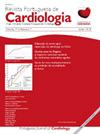等待时间对等待主动脉瓣置换术患者预后的影响。
IF 1.6
4区 医学
Q3 CARDIAC & CARDIOVASCULAR SYSTEMS
引用次数: 0
摘要
简介和目的:主动脉瓣置换术是治疗严重主动脉瓣狭窄的唯一有效方法。干预应尽快进行,以降低心力衰竭和死亡的风险。我们的目的是评估转诊到手术中心和对严重AS诊断的患者进行AVR之间的时间,以及它可能对住院和死亡率的影响。方法:这是一项回顾性研究,包括2018年1月至2021年12月期间在手术中心接受AVR治疗的241例严重AS患者,或在此期间死亡的患者。结果:174例行AVR的非住院患者中,82.2%行手术主动脉瓣置换术(SAVR), 17.8%行经导管主动脉瓣植入术(TAVI)。SAVR和TAVI的中位等待时间分别为226天和426天。在56例接受AVR的住院患者中,89.3%有SAVR, 10.7%有TAVI。SAVR和TAVI的平均等待时间分别为9天和15天。在等待干预期间,13%的患者住院,6%的患者死亡。结论:在我们的研究中发现,AVR的等待时间大大长于门诊方案的推荐时间。等待时间的延长与不良事件发生率的增加有关。本文章由计算机程序翻译,如有差异,请以英文原文为准。
Wait time impact on prognosis for patients awaiting an aortic valve replacement
Introduction and objectives
The only effective treatment for severe aortic stenosis (AS) is aortic valve replacement (AVR). The intervention should happen as soon as possible to lower the risk of heart failure and death. We aimed to assess the time between referral to the surgery center and performing the AVR for a sample of patients with severe AS diagnosis, as well as the impact it may have on hospitalization and mortality.
Methods
This was a retrospective study including 241 patients with severe AS submitted to AVR at the surgery center between January 2018 and December 2021, or patients that died during that period.
Results
In a total of 174 ambulatory patients who underwent AVR, 82.2% had surgical aortic valve replacement (SAVR) and 17.8% transcatheter aortic valve implantation (TAVI). The median wait time for SAVR and TAVI was 226 and 426 days, respectively. From a total of 56 hospitalized patients who underwent AVR, 89.3% had SAVR and 10.7% TAVI. The mean wait time for SAVR and TAVI was 9 and 15 days, respectively. While waiting for intervention, 13% of patients were hospitalized and 6% died.
Conclusions
The wait times for AVR found in our study are substantially longer than recommended for outpatient regimen. Extended wait times are linked to an increasing incidence of adverse events.
求助全文
通过发布文献求助,成功后即可免费获取论文全文。
去求助
来源期刊

Revista Portuguesa De Cardiologia
CARDIAC & CARDIOVASCULAR SYSTEMS-
CiteScore
2.70
自引率
22.20%
发文量
205
审稿时长
54 days
期刊介绍:
The Portuguese Journal of Cardiology, the official journal of the Portuguese Society of Cardiology, was founded in 1982 with the aim of keeping Portuguese cardiologists informed through the publication of scientific articles on areas such as arrhythmology and electrophysiology, cardiovascular surgery, intensive care, coronary artery disease, cardiovascular imaging, hypertension, heart failure and cardiovascular prevention. The Journal is a monthly publication with high standards of quality in terms of scientific content and production. Since 1999 it has been published in English as well as Portuguese, which has widened its readership abroad. It is distributed to all members of the Portuguese Societies of Cardiology, Internal Medicine, Pneumology and Cardiothoracic Surgery, as well as to leading non-Portuguese cardiologists and to virtually all cardiology societies worldwide. It has been referred in Medline since 1987.
 求助内容:
求助内容: 应助结果提醒方式:
应助结果提醒方式:


